Related Research Articles
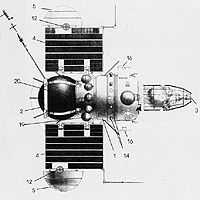
Venera 2MV-1 No.1, also known as Sputnik 19 in the West, was a Soviet spacecraft, which was launched in 1962 as part of the Venera programme.
Venera 2MV-1 No.2, also known as Sputnik 20 in the Western world, was a Soviet spacecraft, which was launched in 1962 as part of the Venera programme. Due to a problem with its upper stage it failed to leave low Earth orbit, and reentered the atmosphere a few days later. It was the second of two Venera 2MV-1 spacecraft, both of which failed to leave Earth orbit. The previous mission, Venera 2MV-1 No.1, was launched several days earlier.
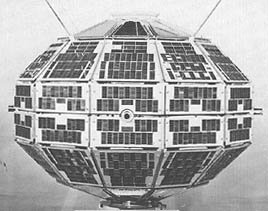
Alouette 1 is a deactivated Canadian satellite that studied the ionosphere. Launched in 1962, it was Canada's first satellite, and the first satellite constructed by a country other than the Soviet Union or the United States. Canada was the fourth country to operate a satellite, as the British Ariel 1, constructed in the United States by NASA, preceded Alouette 1 by five months. The name "Alouette" came from the French for "skylark" and the French-Canadian folk song of the same name.
Kosmos is a designation given to many satellites operated by the Soviet Union and subsequently Russia. Kosmos 1, the first spacecraft to be given a Kosmos designation, was launched on 16 March 1962.

Zenit was a series of military photoreconnaissance satellites launched by the Soviet Union between 1961 and 1994. To conceal their nature, all flights were given the public Kosmos designation.

FalconSAT is the United States Air Force Academy's (USAFA) small satellite engineering program. Satellites are designed, built, tested, and operated by Academy cadets. The project is administered by the USAFA Space Systems Research Center under the direction of the Department of Astronautics. Most of the cadets who work on the project are pursuing a bachelor of science degree in astronautical engineering, although students from other disciplines join the project.
Venera 2MV-2 No.1, also known as Sputnik 21 in the West, was a Soviet spacecraft, which was launched in 1962 as part of the Venera programme, and was intended to make a flyby of Venus. Due to a problem with the rocket which launched it, it failed to leave low Earth orbit, and reentered the atmosphere a few days later. It was the second Venera 2MV-2 spacecraft, both of which failed to leave Earth orbit.
IndoStar-1, which also known as Cakrawarta-1, was a communication satellite that was launched the evening of November 12, 1997 at 21:48 GMT aboard an Ariane 44L-3 rocket from Kourou, French Guiana, as the first direct broadcasting satellite (DBS) in Asia, IndoStar-1 would initiate a new communication service for Indonesian society such as direct-to-home television.

This comparison of orbital launch systems lists the attributes of all individual rocket configurations designed to reach orbit. A first list contains rockets that are currently operational or in development; a second list includes all retired rockets. For the simple list of all conventional launcher families, see: Comparison of orbital launchers families. For the list of predominantly solid-fueled orbital launch systems, see: Comparison of solid-fueled orbital launch systems.

Ariel 2, also known as UK-C, was a British radio astronomy satellite, which was operated by the Science and Engineering Research Council as part of the Ariel programme. It was built in America by Westinghouse Electric, and had a mass at launch of 68 kilograms (150 lb). It was launched in 1964, and became the first satellite to be used for radio astronomy, although the Canadian satellite Alouette 1 was launched 1962 and also did similar radio astronomy observations.
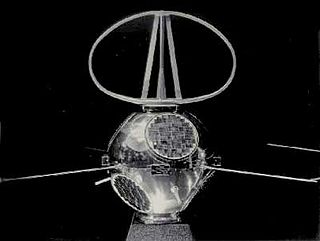
LOFTI-1 was an American satellite which was launched in 1961 and operated by the United States Navy and Naval Research Laboratory. It was used to conduct research into the propagation of very low frequency radio signals in the ionosphere, and to investigate if these signals could be received by submarines. A 136.17 MHz transmitter was used for this investigation.
USA-221, also known as FalconSat-5, is an American military minisatellite, which was launched in 2010. The fifth FalconSat spacecraft to be launched, it carries four technology development and ionospheric research experiments. The satellite was constructed and is operated by the United States Air Force Academy.

Notable spaceflight activities in 2017 included the maiden flight of India's Geosynchronous Satellite Launch Vehicle Mark III on 5 June and the first suborbital test of Rocket Lab's Electron rocket, inaugurating the Mahia spaceport in New Zealand. The rocket is named for its innovative Rutherford engine which feeds propellants via battery-powered electric motors instead of the usual gas generator and turbopumps.
Technology Education Satellite (TechEdSat) is a class of CubeSats built by San Jose State University and University of Idaho students in partnership with NASA's Ames Research Center. These satellites have tested communication technology for smallsats, and have contributed to the development of the Small Payload Quick Return (SPQR) concept.

This article documents notable spaceflight events during the year 2020.
SOLRAD 7A was the seventh solar X-Ray monitoring satellite in the SOLRAD series, and the fourth to successfully orbit the Earth. It was boosted into orbit along with four other military satellites atop a Thor Augmented Delta-Agena D rocket on January 11, 1964. Data returned by SOLRAD 7A dramatically revised scientific models of the solar corona.

SOLRAD 4 was a solar X-rays, ultraviolet, and electronic surveillance satellite. Developed by the United States Navy's United States Naval Research Laboratory (USNRL), it was the fourth in both the SOLRAD and the GRAB programs.
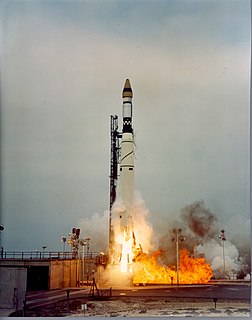
SOLRAD 7B was the eighth solar X-Ray monitoring satellite in the SOLRAD series and the fifth to successfully orbit the Earth. It was launched via Thor Augmented Delta-Agena D along with seven other satellites on March 9, 1965. The satellite provided continuous coverage of the Sun during the International Quiet Solar Year from March through October 1965.
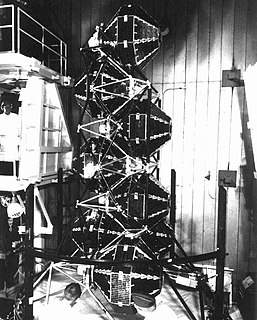
The Initial Defense Communications Satellite Program or IDCSP was the first United States Department of Defense communications satellite constellation and the first stage of the Defense Communications Satellite Program (DCSP). Launched in five groups by Titan IIIC launch vehicles to near equatorial, subsynchronous orbits between 1966 and 1968, they were intended to be experimental testbeds. They were so successful that, by the time of the launch of the last set of eight satellites, the IDCSP was deemed operational and renamed Initial Defense Satellite Communications System or IDSCS. This system allowed real-time collection of battlefield intelligence during the Vietnam War. A total of 35 IDCSP satellites were launched, 27 successfully.

The Environmental Research Satellite program was a series of small satellites initially operated by the United States Air Force Office of Aerospace Research. Designed to be launched "piggyback" to other satellites during launch, detaching once in orbit, they were the smallest satellites launched to date—what would today be classified as microsatellites. 33 ERS satellites in six different series were launched between 1962 and 1971, conducting scientific research and serving as test beds to investigate the reliability of new spacecraft components.
References
- ↑ Electro-Optical Systems (1966). Richter, Henry (ed.). Instruments and Spacecraft, October 1957-March 1965: Space Measurements Survey. Scientific and Technical Information Division, National Aeronautics and Space Administration. pp. 239–240, 430.
- 1 2 Krebs, Gunter. "LOFTI 1, 2". Gunter's Space Page. Retrieved 12 July 2022.
- ↑ "USN 711008: Lofti II Satellite". history.navy.mil. Retrieved 12 July 2022.
- ↑ "Composite Launch Attempt Fails". Aviation Week and Space Technology. p. 29.
- ↑ Krebs, Gunter. "LOFTI 2A". Gunter's Space Page. Retrieved 12 July 2022.
- ↑ Brescia, R.; Ballou, D.; Zirm, R. Decay Prediction of 1963-21 Using U.S. Naval Space Surveillance System Observations (PDF) (Report). Retrieved 12 July 2022.